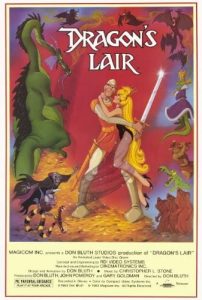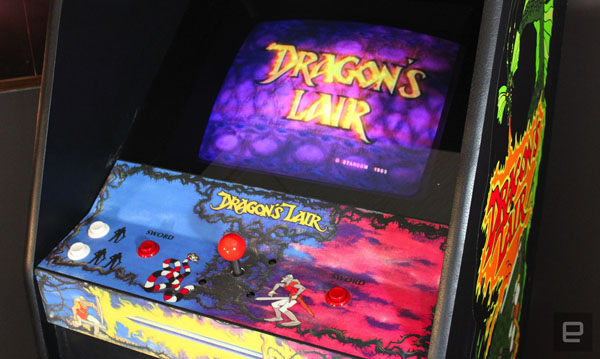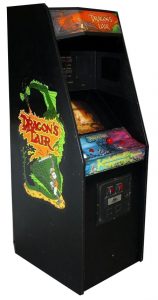Suspended Animation #284
In March 2020, it was announced by many media outlets that actor Ryan Reynolds would produce and star in a live-action film for Netflix based on the popular video arcade game Dragon’s Lair.
Roy Lee will co-produce through his Vertigo Entertainment with Trevor Engelson of Underground Films. Don Bluth, Gary Goldman and Jon Pomeroy who produced the original game will also be listed as producers. Reynolds will produce through his Maximum Effort production company.
The assumption is that Reynolds would play Dirk the Daring character. Dan and Kevin Hageman, whose credits include The Lego Movie and Scary Stories to Tell in the Dark are attached to write the script.
Dragon’s Lair was originally released for arcades in 1983 by Cinematronics. The game used laserdisc technology to provide superior graphics and feature film quality animation from Don Bluth Studios.

Dragon’s Lair was ported to numerous home consoles over the years, including recent ports for the Nintendo Switch, Xbox One and Playstation 4. The game also boosted the popularity of both Bluth and Goldman, who eventually went on to the creation of a series of popular animated feature films.
 In 2015, Bluth and Goldman ran a Kickstarter campaign to fund a “proof of concept” teaser for a full length animated feature based on the property but failed to raise the necessary funds. They moved the plea over to Indiegogo where they eventually raised almost twice the amount they were asking. Netflix apparently has been in negotiations for over a year to obtain the property.
In 2015, Bluth and Goldman ran a Kickstarter campaign to fund a “proof of concept” teaser for a full length animated feature based on the property but failed to raise the necessary funds. They moved the plea over to Indiegogo where they eventually raised almost twice the amount they were asking. Netflix apparently has been in negotiations for over a year to obtain the property.
The original game followed the adventures of the brave but not brilliant Dirk the Daring in his quest for Princess Daphne. Game players had to manevuer Dirk through a series of short deadly challenges to get through the castle that is the Dragon’s Lair to defeat the dragon holding the princess prisoner. If a player died in an attempt, Dirk would drop into the frame with a look of digust and dissolve into a crumbling skeleton.
Bluth and his studio composed of artists who had done The Secret of NIMH (1982) had to work under a strenuous deadline and under complete secrecy, not even telling family members. Bluth’s devotion to have the highest quality animation pushed the budget over its initial one million dollar budget.
Bluth concentrated on speed with shorter scenes and bigger payoffs so the animation was broader and more cartoony than his usual work so it could be read easier by players.
The voices for the game were the crew themselves. Dirk’s various “ooh-ahh-eee’s” were voiced by sound engineer Dan Molina. Daphne’s squeaky “Save me” was from Vera Lanpher, head of the assistant animators.

Because of the technology, the cost of a game unit was over $4,000, nearly twice the cost of a regular game. In addition, it would cost fifty cents per play rather than a quarter. Arcade owners were told it would be a good investment because future games could simply be inserted into the same machine.
 No one, not even Bluth was prepared for how well the game was instantly received. Some individual machines generated as much as a thousand dollars a day. Pioneer was not able to supply the needed laser units and Dragon’s Lair debuted with less than 5,000 units when it became apparent the demand was for at least 20,000 to 30,000 immediately.
No one, not even Bluth was prepared for how well the game was instantly received. Some individual machines generated as much as a thousand dollars a day. Pioneer was not able to supply the needed laser units and Dragon’s Lair debuted with less than 5,000 units when it became apparent the demand was for at least 20,000 to 30,000 immediately.
At the time, Bluth stated, “We’re appealing, in LAIR, to the people who didn’t see NIMH – teens. Maybe if they get used to the Bluth name in arcades, they might go to the theaters and see the films.”
According to Bluth, director Steven Spielberg contacted the crew to congratulate them and had thought classical animation was dead until he’d seen NIMH and suggested the two team up on a future project.
As my friend John Cawley who worked at Bluth Studios for a while told me, “When the game was first being tested and shown at the gaming conventions, a few test scenes as well as test discs were produced. For the same reason some films have scenes cut (they’re too slow, not what was hoped for, too long, etc.), Starcom dropped some scenes. There is a scene of a one- eyed, pig-like creature throwing a spear that doesn’t appear in the final game. All this gave rise to the urban legend of secret scenes you could somehow access in the game.”
Bluth’s dislike of television animation prevented his studio from having any real participation when the game was transferred to a television series produced by Ruby Spears that debuted in the fall of 1984. Even though Bluth had script approval, he rarely read them. He did however give Ruby Spears model sheets of the characters but scantily-clad Daphne had to be re-clothed for Saturday morning audiences.
 The series was developed by Rick Merwin and Paul Dini. The concept for the Dragon’s Lair series was described as, “DRAGON’S LAIR is a story of ‘quests’, of missions undertaken by Dirk the Daring at the behest of Ethelred, his king and father of the object of his love, Princess Daphne.”
The series was developed by Rick Merwin and Paul Dini. The concept for the Dragon’s Lair series was described as, “DRAGON’S LAIR is a story of ‘quests’, of missions undertaken by Dirk the Daring at the behest of Ethelred, his king and father of the object of his love, Princess Daphne.”
Along with Dirk, Daphne and the dragon (now able to talk and named Cinge), a number of new characters were introduced. These included Bertram, Dirk’s faithful horse, who did not talk but did “communicate through a wide variety of facial expressions and noises.”
Squire Timothy was described as “a bit shorter than Dirk, and a good deal younger. He has a youthfully simple, innocent way of looking at things, and knack for knowing something is about to happen before it happens”. King Ethelred was Daphne’s father and a “good king.” Sir Hubert Blunt was “to Dirk what Bluto was to Popeye. He’s Dirk’s arch-rival and nemesis, a not-so-friendly competitor for the King’s favor, for treasure, and for just about everything else in life.” Other villains were to also come from the game including the Lizard King and Phantom Knight.
Bluth did receive some interest in doing a theatrical feature so work was begun on Dragon’s Lair: The Legend. Alan Dean Foster who at the time was famous for writing successful novelizations of popular movies participated in the story sessions.
Bluth told a reporter, “We figure we can fashion a really good DRAGON’S LAIR movie. We’re pulling out all the stops. We’re going to give them everything they want to see. Answer all their questions about our hero, Dirk, and his background. At the same time, we’re not going to aim the subject matter at the nursery level. We’re going to aim up.”
Bluth developed a story of how Dirk and Daphne met as teenagers. The tale revolved around an evil, Horned King-like sorcerer named Mordrock, seeking to raise an army of corpses from a river of the dead.
A short film was produced to interest investors. It consisted of thirty or so lavish story sketches narrated in almost Biblical solemnity by Michael Rye. Bluth said he wanted Michael J. Fox as the voice of Dirk. When the game market died, so did any interest in doing a feature.
Bluth also worked on a sequel to the Dragon’s Lair game, another game called Space Ace and even a computer game featuring Zorro. But those are stories for another time.



 Jim Korkis is an internationally respected animation historian who in recent years has devoted his attention to the many worlds of Disney. He was a columnist for a variety of animation magazines. With his former writing partner, John Cawley, he authored several animation related books including The Encyclopedia of Cartoon Superstars, How to Create Animation, Cartoon Confidential and Get Animated’s Animation Art Buyer’s Guide. He taught animation classes at the Disney Institute in Florida as well as instructing classes on acting and animation history for Disney Feature Animation: Florida.
Jim Korkis is an internationally respected animation historian who in recent years has devoted his attention to the many worlds of Disney. He was a columnist for a variety of animation magazines. With his former writing partner, John Cawley, he authored several animation related books including The Encyclopedia of Cartoon Superstars, How to Create Animation, Cartoon Confidential and Get Animated’s Animation Art Buyer’s Guide. He taught animation classes at the Disney Institute in Florida as well as instructing classes on acting and animation history for Disney Feature Animation: Florida.




















































I was the owner of several arcades when this game came out. Most of what you say about the coin operated machine is true, but…..
The disc player used was a home model not designed for constant duty LOCKED INSIDE A WOODEN BOX with no ventilation and constant vibration. The failed often and repairs could not be done on site. Shipping both ways and bench time took weeks. Many customers were disappointed when they came in to play the machine and it was dark
.
Also, just like the movie business, games can be hot for a brief amount of time and then drop suddenly, or they can be steady long term earners with “legs”.. 90 days after introduction, play on these just tanked.
There is no mechanical way for a 3 to 5 minute game at 50 cents to make 1000 dollars in an 8-10 hour day. Do the math. The media at the time was rabid about how much money arcades were making and most income claims were baloney.
Because of all the time and money spent on the animation, there was no way the creators could afford a second or third screen adventure. Players would spend like crazy to get all they way to the finish, and then the game just ended. Games like Mario Brothers or Donkey Kong presented a whole new world after you finished the first, leaving the player wanting to spend more.
I also doubt the inflated claims of 5000 units sold. The factory was much smaller than Atari or Midway, and the game dropped so quickly that the number you claim as PRODUCTION might have just been ORDERS. The only way to figure out how many were made is to get a good size sample of serial numbers and line them up. My guess is around 1000. .. .
To me and my friends, this game was a real stinker.
The gameplay sucked and the lag time was awful.
A big greeting and grateful shout-out to Tim Arnold — Pinball Pete,” himself! — whose wonderful East Lansing, Michigan arcades, crammed with great pinball machines and video games, remain much remembered (and greatly missed) by those who spent many happy hours there (and spent many, many quarters there) back in the day.
Tim is right about the significant amount of down-time of the DRAGON’S LAIR machines; it seemed as if they were always dark. It was an ambitious concept, and Bluth and company produced some interesting (and full) animation for the game… but the technology just wasn’t there yet for a workable, dependable machine. And as Tim notes, the disc players used in the machines weren’t exactly the costly industrial laser players needed for constant use; frequent breakdowns were inevitable. But DRAGON’S LAIR did stretch the idea of what a video game could be, and doubtless inspired future game designers and programmers.
I remember shrugging off DRAGON’S LAIR when it came out, but for some reason I was fascinated by its’ successor, SPACE ACE. As someone with very little skill at video games, I felt as if I was personally responsible for that $1000 per day take you mentioned.
Oh, if I only had all those quarters now….
In reference to the above replies, I too played at Pinball Pete’s in the Frandor shopping center in E Lansing. I’m amazed how many comments to this site come from us Michiganders (Small world?)
Apparently Don Bluth founded a new animation studio that’ll make hand-drawn animation. I actually believe that even computer generated animation is fine as long as it uses the traditional animation principles but I still applaud Bluth for what he’s attempting to do. With Cuphead, Looney Tunes Cartoons, and now Don Bluth Studios it seems there is hope for those of us who like vintage American animation. I don’t even consider myself a Don Bluth fan yet I still applaud him for his passion and care for the art form
Can someone turn East of the Sun and West of the Moon into movie, or Satyrday. And make both The Other Side of the Wind Don Bluth movies.
The Sea Beast and Barnacle Bill, Do it, damm it!
Ok – rant over!